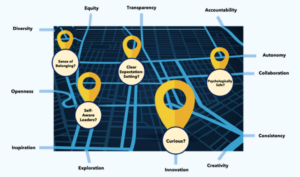
Why Is Productivity Slipping? Maybe That’s The Wrong Question
Productivity metrics were essential 100 years ago, during the manufacturing age. At that time, organizations measured success with metrics like hours worked, revenue per employee,

Productivity metrics were essential 100 years ago, during the manufacturing age. At that time, organizations measured success with metrics like hours worked, revenue per employee,

Sponsored by The Culture Platform What makes maps so special is they tell you exactly where to find places you want to visit. Wouldn’t it

With so many interesting new HR tools available lately, are you wondering if more modern HR analytics could improve your workforce planning capabilities? In a

Sponsored by The Culture Platform What tools actually help managers manage their people? That’s the most important question every organization needs to ask itself as the

In a world filled with uncertainty, one thing is certain. “Business as usual” is no longer a realistic strategy. So, during unusual times like this, is

When it comes to implementing a successful engagement strategy, HR teams can’t afford to ignore employee expectations. Yet, research suggests that too many organizations forget

In today’s ever-shifting talent landscape, companies large and small are searching for more effective ways to attract, recognize, and retain their workforce. These opportunities come

Data has percolated into every area of business — from the hiring process, to marketing programs, to charting a company’s strategy for the future. In

Many managers and HR practitioners are familiar with 360 feedback as a leadership development practice. However, no two 360 feedback experiences look alike. That is

When someone says it’s time for performance evaluations, what happens? You can almost hear a collective groan ripple across an organization. Reactions run the gamut,

In my experience, one of the biggest HR investments aside from payroll tends to be in performance management. This shouldn’t come as much of a

In a rapidly evolving digital world, human resources are the biggest asset for any organization. Thus, creating a culture of learning is essential to tap

I want you to look around at your employees — in person where possible, and on that Zoom call. Then, I want you to think

2020 is changing the way we work, without question. As the nature of the workplace transforms, performance management faces new challenges. We’ve seen many workforces

In the past several months, many companies have modified their performance programs. From streamlining their review processes to running more frequent pulse surveys, organizations around

Listen to the full conversation and see our questions for the upcoming #WorkTrends Twitter Chat. And don’t forget to subscribe to the podcast, so you

Coronavirus has changed the way American businesses operate, to say the least. And from work-from-home mandates to reopening strategies to locking down again in the

The second in a two-piece series on Continuous Listening. In Part One of my series on Continuous Listening, I looked at the flaws of taking
This is the first in a two-piece guest series on Continuous Listening. Human Resources departments own many responsibilities that directly contribute to the overall success

We know that people are happier and healthier when they know their work matters — and performance reviews can be a powerful tool to help

The opening keynote speaker at UNLEASH America was Gary Hamel, one of the world’s most influential business thinkers. He is a professor at the London

How could you get better at your job? What does your manager think about your performance this month? And what are your ideas about how

Recruiting the right employees is a time-consuming and important process. Hiring the right people is critical to the organization achieving its goals. But what happens

The right partnership is key for successful performance management. Here are some expectations you should set for consultants you work with.

Everyone wants to improve their performance management, but doing it isn’t that easy. Meghan M. Biro looks at the key reasons we fail and how to succeed. It’s all about the tech.